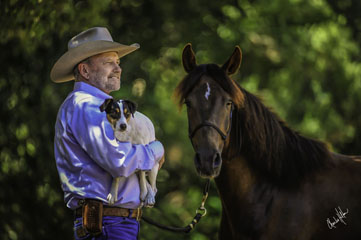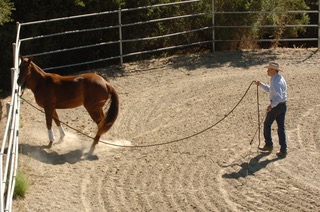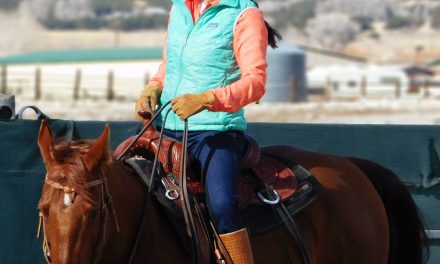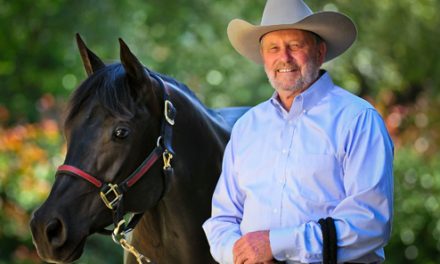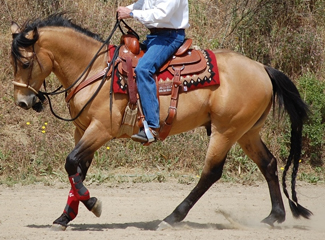
Sage and Toby
Teaching a horse to ground tie is one of the easiest commands to train. I’ve seen some elaborate ways of teaching a horse to ground tie. Some trainers put a line on the halter and a second line between the front legs and through a surcingle. If the horse moves forward, the trainer pulls on the lines. Some trainers tie the horse to an object on the ground which teaches the horse where it needs to stand. I use a much more simple method.
There are some prerequisites before you do this exercise. You first need to know that the horse has respect for the halter. If you ask the horse to back up and he shoves his nose forward and plants his feet, you are not ready to go on with this exercise or any other method of teaching this skill. You need to be able to ask your horse to back up with a light cue and have the horse response promptly and with some energy. Also, your horse must have a solid forward cue.
You need to be able to control the horse’s shoulders. Stand facing your horse, slightly off to the left. With your left hand under the snap of the lead rope, use your right hand ask the horse to move and the shoulder should move over. This applies to the right as well. Once you have control of your horse in four different directions (we actually do this by backing the horse, having the horse move forward, and moving the shoulders to the left and right), you are ready to do the exercise.
There are a couple of concepts we should discuss and timing is one of them. If your horse is being rude and obnoxious, it is not a good time for this or any other exercise. The horse is not going to listen. It is not a good time to do this exercise immediately after taking your horse out of the stall. If the horse is fresh, he is not going to be motivated to stand still. This is a good lesson to do after longeing a horse or under saddle after a nice ride when the horse is tired; that would be a perfect time for this lesson.
Another concept is that you must trust your horse. For example, I back the horse with a verbal and physical cue, tell the horse to “whoa” and then drop the line and walk away like I know he is going to stand where I left him. I know he will not stay but I act like he will stand. What most people want to do is back up the horse, say “stay” and allow their hand to linger on the line and try to force the horse to stay. You must allow the horse to make a mistake and come forward.
Once the horse has made the mistake of walking forward, you can make a correction in a way that motives a change in behavior. When the horse follows, immediately (within two or three seconds) turn around and back the horse two or three steps with energy, purpose and authority. That behavior will give the horse a reason to make a change. Then release the line and walk away six or eight feet. The horse will likely walk forward again. Turn around, immediately use your back up cue and repeat the exercise. If the horse moves to the left or right, control his shoulders. If the shoulder has gone right, put your right hand on the lead under the snap and with your left hand ask the horse to move over.
I begin this exercise by putting the horse on a twelve-foot line. I like to work with a fairly thick dressage stick. I take the lash off so there is no sting. You can use a training stick, a twig off a tree or, if you are comfortable, the lead rope. The stick is used only as an extension of your arm. You will need to reach out and tap the shoulder to put it back where it belongs if the horse moves sideways.
We begin by standing in one spot, “X” and here there may be some confusion. Because we have to make corrections, our spot will change. You may start at one end of the arena and finish at the opposite end. It is not necessary or even desirable to return to the original spot. The exact “X” spot is where you finish each time. If you want, you could place a cone to help you mark “X” but it is more confusing for the horse if you continually return to the cone. If you move the horse forward to return to the cone, you have disrupted your command and that is counterproductive. It is easier to just start with a new spot. If the horse moves to one side or the other, move him over and say “whoa.” I like the word whoa but you can say “stay” or “halt” if you are of the English discipline.
You may want to begin the exercise with a regular lead line and progress to a 25-foot line which will allow you to move further and further back. The cue for this command is the lead rope touching the ground. When I ask my horse to stop, I put slack in the rope and immediately drop it to the ground. Your horse should figure this out in a relatively short time. To get the command solid, it may take three or four lessons. The key is to mean it when you make the correction. Make the horse work by backing him several feet with authority or you can move his shoulders a few steps by controlling his feet. You control the mind when you control the feet. You can also use this exercise to teach your horse to stand away from you or to stand while you mount.

